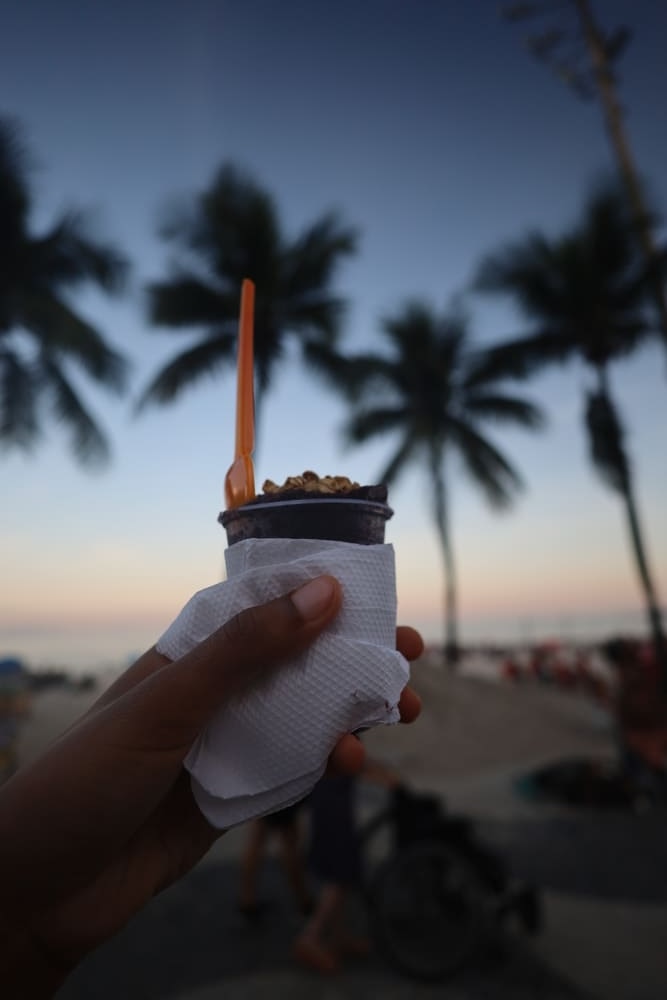
Planning your first trip to Rio de Janeiro but not sure where to begin? You’ve come to the right place.
Disclosure: This post may contain affiliate links, which means we’ll receive a commission if you purchase through our links, at no extra cost to you. Please read full disclosure for more information.
Whether you’re dreaming of lounging on Copacabana’s famous beaches or exploring the vibrant streets of Rio, there are a few key things to know before you go.
This guide is packed with essential Rio de Janeiro travel tips, from cultural insights to practical advice, all designed to make your visit smooth and unforgettable.
As one of our favorite cities in the world, we want to help you fall in love with it just like we did.
Let’s dive into everything you need to be fully prepared for your trip to Rio!
Where is Rio
Rio de Janeiro is located in the southeastern part of Brazil and is the second-largest city in the country, home to over 6 million people.
Situated in the Southern Hemisphere, Rio’s seasons are opposite to those in the Northern Hemisphere.
However, thanks to its tropical climate, Rio stays warm year-round, with hot and humid weather.

RELATED ARTICLE: Ultimate Carry On Packing List
How to Get to Rio de Janeiro
When flying to Rio de Janeiro, you’ll arrive at either Galeão International Airport (GIG) or Santos Dumont Airport (SDU).
GIG is the larger airport, located about 12 miles (20 km) from Rio’s downtown area, while SDU is closer, just 1 mile (2 km) away.

If you’re flying domestically within Brazil, like from São Paulo, you’ll likely arrive at SDU, Rio’s domestic airport. However, international flights will land at GIG, the city’s only international airport.
We flew from JFK Airport in New York for $430 USD per person roundtrip with Avianca Airlines, landing at GIG.
It took about an hour by Uber to reach our Airbnb in Leblon, costing $17.51 USD.
Looking for flight deals for when you travel to Rio de Janeiro?
Download our free resource with the top 9 ways to find cheap flights by signing up below!
Do You Need a Visa to Visit Rio de Janeiro Brazil?
Currently, U.S. citizens do not need a visa to visit Brazil, but this will soon change.
Starting at midnight on April 10, 2025, a visa will be required for U.S. citizens traveling to Brazil for any purpose.

For more information on visa requirements, visit the official Brazilian government site.
As a U.S. citizen you’ll need:
- A valid U.S. passport.
- A valid Brazilian visa or e-visa (required for tourists starting April 10, 2025).
We’ll keep this section updated with any changes for U.S. travelers.

Language
Portuguese is the official language of Brazil.
At first glance, I assumed my Spanish skills would help, given Brazil’s proximity to Spanish-speaking countries in South America.

But Portuguese sounds quite different, and only about 4% of people in Brazil speak Spanish.
To make matters trickier, many locals don’t speak English either.

Thankfully, the Translate app was a lifesaver, helping us communicate throughout our time in Rio.
I definitely recommend that you use either the Translate app or Google Translate during your time in Rio if you’re unfamiliar with Portuguese.

Currency
Brazil’s official currency is the Brazilian Real (BRL), with 1 Real equaling around $0.18 USD.
When we arrived in Rio, we withdrew 700 reals from an ATM using our Charles Schwab debit card, which is great because it reimburses ATM fees and has no foreign transaction fees.
However, we rarely used cash since credit cards were accepted almost everywhere—even by small vendors on the beach!

We recommend bringing a credit card with no foreign transaction fees, and when paying, always choose the local currency for the best exchange rate.
Best Season to Visit Rio de Janeiro
Rio de Janeiro enjoys warm weather year-round. The hottest months are from November through March, with temperatures sometimes exceeding 100°F (43°C).
If you’re aiming to experience the world-famous Rio Carnival, plan your trip between late February and early March.

Be sure to check the exact dates of Carnival in advance. Keep in mind, though, that this is peak season, so expect higher prices and larger crowds.
For fewer tourists and milder weather, consider visiting in April, May, September, or October during the shoulder season.
If you prefer cooler temperatures, Rio’s winter months from June to August offer highs around 80°F (26°C).
How to Stay Safe in Rio de Janeiro
If you’re wondering, “Is Rio de Janeiro safe?” it’s important to note that while Rio has areas that require extra caution, particularly the favelas and isolated back streets at night, we felt safe during our visit.
We stayed in Leblon and mainly stuck to well-populated areas during the day.

That said, use common sense: if a situation feels off, don’t stay.
If you find yourself in a dangerous situation, give whatever items they’re asking for without fighting.
Avoid bringing valuables everywhere, and at the beach, keep your belongings with you—waterproof bags and fanny packs are handy for this.
Leave expensive jewelry at home to avoid drawing attention, and don’t explore favelas on your own.
Uber is an affordable and safe way to get around.

Finally, emergencies happen when least expected, so we recommend Safety Wing travel medical insurance. It’s affordable and offers wide coverage.
Get a quote for your Safety Wing Travel Medical Insurance plan here to stay protected during your Rio trip.
How to Get Around Rio
While Rio has many walkable areas, not all routes are ideal for walking.
Google Maps might show a straightforward path from point A to point B, but in reality, some routes may take you through favelas with steep hills and many stairs.

We experienced this firsthand—it was daylight, and we reached our destination safely, but we wouldn’t recommend taking unfamiliar routes through favelas, especially if you’re not familiar with the area.
For the most budget-friendly option, consider Rio’s subway system, the MetrôRio.
To use it, buy a Giro card at the self-service terminals in major stations. The card costs ~$2.19 USD, which includes a ~$0.81 USD deposit for the card and ~$1.39 USD for rides.

A single journey on the metro costs ~$1.39 USD. The MetrôRio is known for being clean, air-conditioned, and safe.
That said, Uber is actually our top recommendation for getting around Rio. It’s cheap, reliable, and safe.
Keep in mind that traffic tends to increase between 5-7 p.m. on weekdays, so allow extra time in your schedule or consider taking the metro during these peak hours.
Where to Stay in Rio de Janeiro
Rio offers a variety of accommodation options, and since it’s easy to get around, we recommend staying close to where most of your Brazil itinerary will take place.

Avoid staying in favelas, and make sure you understand the location of your accommodation before booking.
For beach lovers, Copacabana and Ipanema are prime spots.

We stayed in Leblon, which is close to Leblon Beach but also gives more of a city feel.
Since all these areas are easily accessible from one another, any of them are great choices—just pick the one that best suits your budget and travel style.
Accommodations We Recommend:
- The Airbnb We Stayed in (Leblon)
- Sheraton Grand Rio Hotel & Resort (Leblon)
- Selina (Copacabana)
- Miramar by Windsor (Copacabana)
- Ipanema Beach Hostel (Ipanema)

What to Pack
- antitheft day bag
- waterproof bag
- waterproof fanny pack
- swimwear
- light, breathable clothing
- comfortable walking shoes
- waterproof phone case
- universal power adapter
- sun visor or sun hat or bucket hat
- sunscreen
- bug spray
- reusable water bottle with filter straw (the tap water is not safe to drink in Rio)

Lifestyle & Diversity in Rio
Rio has a vibrant health-conscious culture. You’ll see workout stations scattered throughout the city, with locals staying active by exercising and playing sports along the beach.
Superfruits like açaí and cupuaçu are also popular, contributing to the healthy lifestyle.

We noticed a lot of diversity as soon as we arrived.
Brazil has the largest Black population outside of Africa, so you’ll find people of all shades here.
The diversity helped us feel more comfortable, and we felt like we fit right in.

What to Eat in Rio de Janeiro
Rio is a foodie’s paradise, with lots of meats and superfruits to try.

Some must-eats include pão de queijo (cheese bread), açaí, cupuaçu (my personal favorite superfruit), pastel (similar to an empanada), and feijoada, Brazil’s national dish—a black bean and meat stew.

Our favorite spots to eat were ASA Açaí for açaí bowls, though the cheapest ones are from the vendors right on the beach.

For brunch, Nusa Café was a hit, and the best dinner we had was at Yaya Comidaria Pop Brasileira.

Also, don’t leave without trying a caipirinha, Brazil’s famous cocktail made with cachaça, lime, sugar, and ice!

Best Things to Do in Rio de Janeiro
If you’re planning a trip, you’re going to want to know not only where to stay and where to eat, but exactly what to do in Rio de Janeiro, Brazil.

Here’s some of our top picks:
- Visit the iconic Christ the Redeemer statue at the summit of Mount Corcovado, named one of the New Seven Wonders of the World in 2007.
- Take the Sugarloaf Mountain cable car to the summit of this UNESCO World Heritage Site for panoramic views of the city.
- See the colorful Escadaria Selarón steps, an iconic spot best visited early in the morning to avoid crowds.
- Relax at world-class beaches like Copacabana and Ipanema, famous for their sunsets.
- For an unforgettable sunrise, head to Mirante Dona Marta for incredible city views.
- Explore the Museum of Tomorrow (Museu do Amanhã), a science museum focused on sustainability and humanity’s impact on the future.
- Try out some water sports and take a surfing lesson.
- Stroll through the beautiful Jardim Botânico.
- If you’re up for hiking, tackle Pedra do Telégrafo or Pedra da Gávea for breathtaking views.
- Get a new perspective of Rio with a helicopter ride or try hang gliding for an adrenaline rush.

How Many Days to Spend in Rio
A minimum of 3 days is recommended to spend in Rio de Janeiro, but you can easily spend weeks exploring Rio! (Take as much time as your PTO allows!)

This guide was all about things to know before going to Rio de Janeiro, but for more inspiration and planning tips, check out our 5-day Rio de Janeiro itinerary blog!



